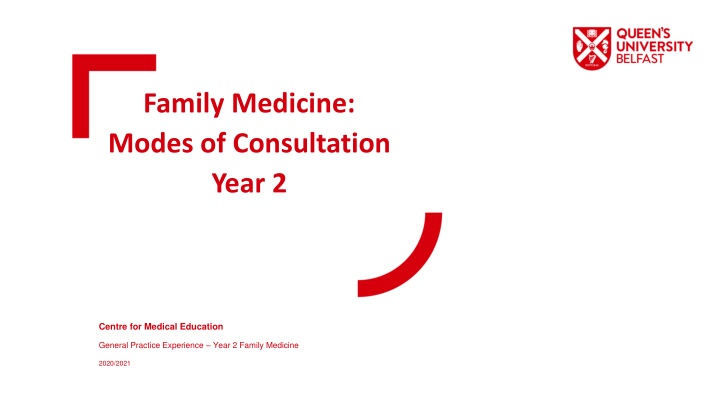
Exploring Modes of Consultation in Family Medicine Year 2
Discover the traditional and contemporary consultation methods available to healthcare professionals, assessing their benefits and drawbacks. Delve into the impact of Covid-19 on healthcare consultations and the future of remote healthcare practices.
Download Presentation

Please find below an Image/Link to download the presentation.
The content on the website is provided AS IS for your information and personal use only. It may not be sold, licensed, or shared on other websites without obtaining consent from the author. If you encounter any issues during the download, it is possible that the publisher has removed the file from their server.
You are allowed to download the files provided on this website for personal or commercial use, subject to the condition that they are used lawfully. All files are the property of their respective owners.
The content on the website is provided AS IS for your information and personal use only. It may not be sold, licensed, or shared on other websites without obtaining consent from the author.
E N D
Presentation Transcript
Family Medicine: Modes of Consultation Year 2 Centre for Medical Education General Practice Experience Year 2 Family Medicine 2020/2021
Aim of session To introduce students to the traditional and newer modes of consultations open to GPs and other clinicans and consider their advantages and pitfalls
Background Modes other than Face to face are not new Triggers to broaden the modes include infection control and patient convenience BUT Covid19 has accelerated their use throughout healthcare exponentially General Practice has been quick to adopt and adapt These quickly adapted modes are likely to remain beyond Covid19
Where do consultations take place in Primary Care?
Where do consultations take place in Primary Care?
Brainstorming the different modes
Brainstorming the different modes Face to face Telephone Video Online/text based
Examining during video consultations What can you observe e.g. colour Could someone with the patient help e.g. describing their breathing, counting their resps What about home obs e.g. home BP monitor What about intimate or semi-intimate examinations? Need for a chaperone?
Advantages of remote consultations
Advantages of remote consultations Convenience for many patients e.g. working patients Infection control preserved ?better control for the GP on their workload
Pitfalls of remote consultations
Pitfalls of remote consultations Technical aspects You re on mute Harder to establish rapport and trust Confidentiality who is in their room? Privacy issues Security issues Limitations to examination Are you being recorded?
Who might struggle most with remote consultations
Who might struggle most with remote consultations Older people People without access to the technology People with mental health issues People with learning disability People requiring interpreters People highly concerned with the privacy/security
Safety netting in remote consultations Even more important than in more traditional consultations Think about what you might to record
Family Attachment over Zoom? Students to consider their Family Attachment experience from last year and how this might be different for current first years, who will be meeting their families over video conferencing
Aim of session To introduce students to the traditional and newer modes of consultations open to GPs and consider their advantages and pitfalls
